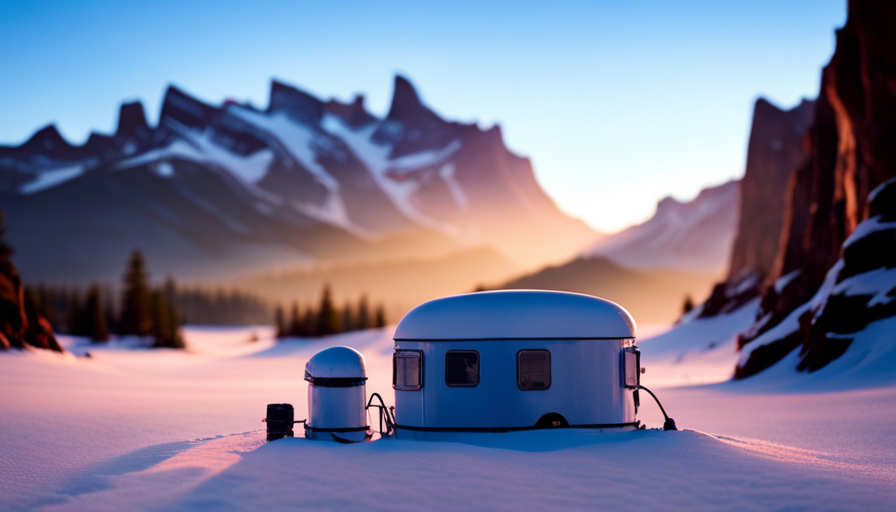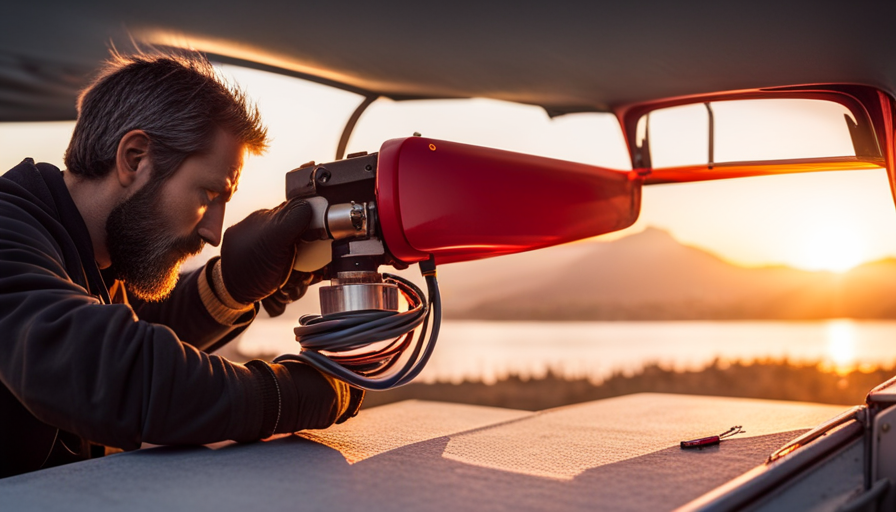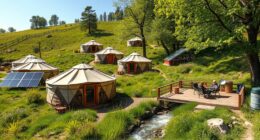Picture this: you’re surrounded by the beauty of nature on a winter camping trip, snug in your dependable camper. The scenery is breathtaking, and the crisp air feels invigoratingly cold. Suddenly, you encounter an unexpected challenge – the water lines in your camper freeze, leaving you without access to water. But there’s no need to panic! With a little know-how and some simple steps, you can thaw out those frozen water lines in your camper and get back to enjoying the great outdoors in no time.
In this article, we will guide you through the process of unfreezing camper water lines. We’ll start by helping you understand the signs of frozen water lines and then walk you through the necessary steps to disconnect, drain, and apply heat to thaw out those pesky frozen areas. We’ll also share tips on insulating your water lines for future prevention, using RV antifreeze, and utilizing portable heaters or electric blankets. And if all else fails, we’ll advise you on when it’s time to seek professional help.
So let’s dive in and learn how to keep those water lines flowing smoothly during your winter adventures!
Key Takeaways
- Signs of frozen water lines include no water coming out of the faucet, strange noises from pipes, and decreased water pressure.
- Preventive measures for frozen water lines in a camper include insulating exposed pipes, maintaining a consistent temperature, and using electric pipe heating tape or a space heater.
- To unfreeze camper water lines, you can apply heat to the frozen areas using a hairdryer, heat gun, or heat lamp. Start at the furthest point and move towards the water source, avoiding direct contact with flammable materials.
- Insulating water lines and keeping the camper properly heated, as well as using RV antifreeze, can help prevent freezing and potential bursting of water lines.
Understand the Signs of Frozen Water Lines
Do you know how to spot frozen water lines in your camper? It’s important to be able to recognize the signs of frozen pipes to prevent further damage.
One of the most obvious signs is when you turn on the faucet and no water comes out. This could indicate that the water line leading to the faucet is frozen.
Another sign is when you hear strange noises coming from the pipes, such as banging or cracking sounds. This could mean that the water inside the pipes has frozen and is expanding, causing pressure and potential damage.
Additionally, if you notice that the water pressure has significantly decreased, it could be a sign of frozen water lines.
To prevent frozen water lines, it’s important to insulate all exposed pipes and keep the interior of your camper at a consistent temperature. You can also use electric pipe heating tape or a space heater to provide extra warmth.
By being aware of these signs and taking preventive measures, you can avoid the hassle and expense of dealing with frozen water lines.
Now, let’s move on to the next section about disconnecting and draining the water system.
Disconnect and Drain the Water System
First, make sure to disconnect and completely drain your entire water system. This is an essential step in preventing freezing and further damage to your camper’s water lines. Here are three key points to keep in mind while disconnecting the water system:
-
Turn off the main water supply: Locate the main water supply valve and turn it off to stop the flow of water into your camper.
-
Open all faucets and drains: To drain the water from your system, open all the faucets and drains in your camper. This will allow any remaining water to flow out and prevent it from freezing.
-
Remove any water filters or cartridges: Before draining the system, make sure to remove any water filters or cartridges. These can trap water, leading to potential freezing and damage.
With your water system disconnected and drained, you can now move on to the next step of applying heat to the frozen areas. This’ll help thaw out the water lines and restore the flow of water in your camper.
Apply Heat to the Frozen Areas
Now, it’s time to warm up those icy spots by applying some gentle heat. Before we begin, it’s important to mention some preventive measures to avoid frozen water lines in the future. Proper insulation and heat tape installation can go a long way in protecting your camper’s water system from freezing temperatures. However, if you find yourself with frozen water lines, there are alternative thawing methods you can try.
To apply heat to the frozen areas, you can use a hairdryer, heat gun, or even a heat lamp. Make sure to keep a safe distance and avoid direct contact with any flammable materials. Start at the furthest point from the water source and work your way towards it. Apply the heat evenly, moving it back and forth to avoid concentrating heat in one spot.
If you’re unable to access a power source, you can use a hot water bottle or heating pad wrapped in towels to gently warm the frozen areas. Leave it in place for a while and monitor the progress. Be cautious not to overheat the pipes, as this can cause damage.
Using these alternative thawing methods can effectively unfreeze camper water lines. However, if these methods don’t work, it might be necessary to move on to the next step, which involves using hot water to thaw the lines.
Use Hot Water to Thaw the Lines
To effectively thaw the frozen areas, you can rely on hot water as a reliable method. Here are four steps to follow:
-
Start by locating the frozen section of the water lines in your camper. This is usually near an exterior wall or under the sink. Take caution not to damage the pipes while identifying the frozen areas.
-
Fill a bucket or basin with hot water from your faucet. Ensure the water’s hot, but not boiling, as extreme heat can damage the pipes. Use a thermometer if necessary.
-
Gently pour the hot water over the frozen sections of the water lines. Start at the lowest point and work your way up. The hot water will gradually thaw the ice, allowing water to flow freely again. Avoid pouring excessive amounts of water too quickly, as this can cause sudden pressure changes.
-
If the frozen sections are difficult to access, you can use a hairdryer to apply heat. Set the hairdryer to a low or medium heat setting and slowly move it along the frozen pipes. Alternatively, you can wrap the frozen sections with heated towels to provide consistent warmth.
By thawing the camper water lines using hot water, you can restore functionality to your plumbing system. However, to prevent future freezing, it’s important to insulate the water lines properly.
Insulate the Water Lines for Future Prevention
One effective way to prevent future freezing is by insulating the water lines, ensuring warmth and protection for your plumbing system. Preventive measures are crucial in avoiding the inconvenience and potential damage caused by frozen camper water lines.
Insulating the water lines helps maintain a consistent temperature and prevents heat loss, ensuring that the water inside the pipes remains above freezing temperatures even in cold weather conditions.
Common causes of frozen camper water lines include exposure to low temperatures, lack of proper insulation, and drafts. Insulating the water lines involves wrapping them with foam insulation sleeves or using heat tape specifically designed for this purpose. Foam insulation sleeves provide an extra layer of protection and help retain heat, while heat tape warms the pipes to prevent freezing.
When insulating the water lines, it’s essential to cover the entire length of the pipes, including any exposed sections, joints, and elbows. Pay attention to areas where the pipes are most vulnerable to cold air drafts, such as underneath the camper or along the outside walls. Additionally, make sure that the insulation materials are properly secured and tightly sealed to maximize their effectiveness.
By taking these preventive measures, you can significantly reduce the risk of frozen camper water lines and the associated headaches. However, insulating the water lines is just one part of keeping your camper safe during cold weather.
In the next section, we’ll discuss how to keep the camper warm during frigid temperatures without relying solely on the water lines.
Keep the Camper Warm During Cold Weather
Bundle up and make your camper feel like a cozy oasis in the midst of an arctic tundra. When it comes to winter camping essentials, staying warm is a top priority. Here are some tips for staying warm in a camper during cold weather:
-
Insulate the windows: Use thermal curtains or window insulation film to prevent heat loss through the windows. This will help keep the cold air out and the warm air in.
-
Seal off drafts: Check for any gaps or cracks in your camper and seal them with weatherstripping or caulk. This will prevent cold air from seeping in and warm air from escaping.
-
Use portable heaters: Invest in a portable electric heater or a catalytic heater to provide extra warmth inside the camper. Just make sure to follow safety precautions and never leave them unattended.
By following these tips, you can keep your camper warm and comfortable during cold weather.
Now, let’s move on to the next section about using RV antifreeze in the water system.
Use RV Antifreeze in the Water System
To ensure that the camper’s water lines don’t freeze during cold weather, it’s crucial to take preventive measures. One effective method is to use RV antifreeze in the water system.
This preventive measure helps protect the water lines from freezing and potentially bursting, thus avoiding costly repairs. RV antifreeze is specifically designed to withstand low temperatures and prevent freezing. It’s important to note that regular automotive antifreeze should never be used in a camper’s water system, as it can be toxic and harmful if ingested.
When using RV antifreeze, it’s essential to follow the manufacturer’s instructions carefully. Typically, the process involves draining any remaining water from the system, adding the appropriate amount of antifreeze, and then running the faucets and flushing the toilet to ensure the antifreeze reaches all parts of the water system.
While using RV antifreeze is an effective preventive measure, it’s important to consider alternative solutions as well. For instance, insulating the water lines and keeping the camper properly heated can also help prevent freezing. Additionally, utilizing portable heaters or electric blankets can provide extra warmth to critical areas.
By taking these preventive measures and considering alternative solutions, you can ensure that your camper’s water lines remain unfrozen during cold weather.
Transitioning into the subsequent section about ‘utilize portable heaters or electric blankets,’ we’ll explore additional steps to keep your camper warm in chilly conditions.
Utilize Portable Heaters or Electric Blankets
Stay cozy and warm in chilly conditions by making use of portable heaters or snuggling up with an electric blanket. When camper water lines freeze, it can be a real inconvenience. However, with the right tools and knowledge, you can prevent frozen pipes and keep your water flowing smoothly.
Portable space heaters are an excellent option for heating your camper and preventing water lines from freezing. These heaters are designed to provide warmth in small spaces and can be easily moved around as needed. Place the heater near the water lines to thaw them out effectively.
Another alternative is to use an electric blanket. Wrap the blanket around the exposed water lines and let the warmth work its magic. The heat from the blanket will help to thaw the frozen pipes.
Remember to keep safety in mind when using these devices, and always follow the manufacturer’s instructions.
In the next section, we will discuss when it might be necessary to seek professional help if needed.
Seek Professional Help if Needed
If you find yourself in a frozen predicament, don’t hesitate to reach out to a professional who can thaw out your icy situation. Seeking professional assistance is crucial when dealing with stubbornly frozen camper water lines.
While there are several DIY methods you can try, sometimes the problem requires the expertise of a trained individual. Here are a few reasons why professional help may be necessary:
-
Specialized Equipment: Professionals have access to specialized equipment such as heat guns, pipe thawing machines, and infrared cameras that can diagnose and solve the issue more efficiently than regular tools.
-
Experience and Knowledge: Professionals have extensive experience dealing with frozen water lines in campers. They possess the necessary knowledge to identify the root cause of the problem and implement effective solutions.
-
Safety: Working with frozen water lines can be risky, especially if you’re not familiar with the process. Professionals have the expertise to handle potentially dangerous situations and minimize any hazards.
-
Time and Convenience: Seeking professional assistance saves you time and effort. They can quickly diagnose and resolve the issue, allowing you to get back to enjoying your camping experience.
By seeking professional help, you ensure that your camper’s water lines are properly thawed and prevent any further damage. Regularly maintaining and inspecting the water system is essential to avoid future freezing issues.
Regularly Maintain and Inspect the Water System
Make sure you regularly check and maintain your camper’s water system to ensure a smooth and worry-free camping experience. Inspecting the water tanks and checking for leaks are crucial steps in this process.
To begin, it’s essential to inspect the water tanks to identify any potential issues. Start by visually examining the tanks for any signs of damage, such as cracks or leaks. Make sure the tank lids are tightly sealed and there are no loose or missing parts. Additionally, check the tank’s interior for any buildup or sediment that may affect the water quality.
Next, it’s crucial to check for leaks throughout the water system. Begin by examining all the connections, including the pipes, faucets, and valves. Look for any signs of water leakage, such as drips or wet spots. If you notice any leaks, promptly repair or replace the affected components to prevent further damage or water loss.
Regularly maintaining and inspecting your camper’s water system is vital to avoid unexpected issues while camping. By regularly inspecting the water tanks and checking for leaks, you can ensure that your water system remains in optimal condition, providing you with a worry-free camping experience.
Frequently Asked Questions
How long does it typically take for water lines to freeze in a camper?
Camper water lines can freeze in as little as a few hours, depending on the temperature and insulation. Signs of frozen water lines include no water flow, reduced water pressure, and frosty or bulging pipes. When exposed to extreme cold, the water inside the lines can freeze, causing blockages and potential damage.
It’s crucial to take preventive measures, such as insulating the pipes and using heating devices, to avoid frozen water lines in campers.
Can I use a hairdryer to apply heat to the frozen areas?
Using a hairdryer to thaw frozen camper water lines is a common method that many people utilize. However, it’s important to note that this approach may not be the most effective or safe option. Using heat tape is a more reliable and efficient method for thawing frozen water lines in a camper.
Additionally, there are alternative methods such as using a space heater or applying warm towels to the frozen areas. These options provide a safer and more thorough thawing process.
Are there any specific types of insulation that are more effective for preventing frozen water lines?
When considering types of insulation for preventing frozen water lines, it’s important to prioritize effectiveness. Insulation materials such as foam board, fiberglass, and reflective foil can all provide varying levels of protection.
Foam board insulation is known for its high insulating capabilities and resistance to moisture. Fiberglass insulation is widely used due to its affordability and ease of installation. Reflective foil insulation is effective in reducing heat transfer.
Ultimately, the choice of insulation should be based on the specific needs and budget of the camper owner.
How often should I inspect and maintain my camper’s water system to prevent freezing?
To prevent frozen water lines in my camper, I need to regularly inspect and maintain my camper’s water system. This involves checking for any signs of leaks, ensuring proper insulation, and verifying that the heating system is functioning correctly.
For example, I could inspect the water lines every month during the winter season. By doing so, I can identify potential issues early on and take preventive measures to avoid frozen water lines.
Regular camper water system maintenance is crucial for preventing freezing and ensuring a hassle-free camping experience.
Is it safe to use a portable heater or electric blanket inside a camper to keep the water lines from freezing?
Using a portable heater as an alternative to prevent water lines from freezing in a camper can be effective. However, it’s important to consider the potential dangers of using electric blankets. Portable heaters provide a more efficient way to keep the water lines from freezing, as they distribute heat evenly throughout the camper. Electric blankets, on the other hand, can pose a fire hazard if left unattended or if they come into contact with water. Hence, it’s safer to opt for a portable heater as a preventive measure.
Can Winterizing My Camper Without an Air Compressor Cause Water Lines to Freeze?
Yes, winterizing camper without compressor can cause water lines to freeze. Without blowing out the water lines with compressed air, there may be residual water left in the lines, which can freeze and cause damage. It’s important to properly winterize your camper to prevent this from happening.
Conclusion
In conclusion, unfreezing camper water lines can be a daunting task, but with the right knowledge and tools, it can be done effectively. By understanding the signs of frozen water lines and taking preventive measures such as insulation and the use of RV antifreeze, you can avoid future freezing issues.
Remember to regularly maintain and inspect the water system to ensure it’s proper functioning. Just like a well-oiled machine, a well-maintained water system will keep your camping adventures flowing smoothly, like a calm river on a sunny day.










